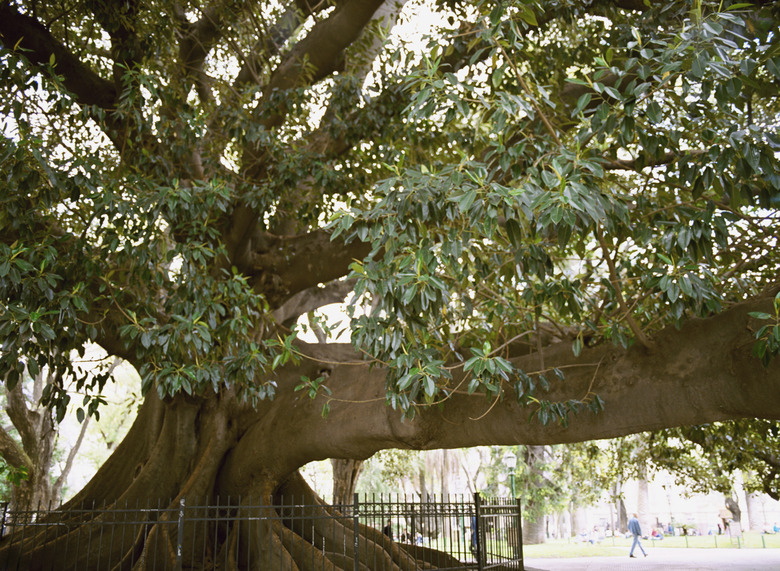What Should I Do If The Neighbor's Tree Is Breaking My Wall?
Trees are planted in rural and urban landscapes to provide shade, to serve as windbreaks or privacy screening and to add aesthetic beauty. Trees provide food and shelter for birds and small wildlife and cleanse pollutants from the air. Unfortunately, trees often cause disagreements between neighbors. The majority of trees have root systems as deep and wide as the width and height of the tree. As the tree matures, it may encroach on the property boundary of adjoining land. Shallow-rooted trees can send out invasive roots or limbs, or branches can fall on a neighbor's fence or wall.
Step 1
If you notice a crack in your garden brick, concrete or stone wall, you may believe that your neighbor's nearby tree is to blame. Trees are often erroneously blamed for foundation or wall subsistence. Evaluate the damage carefully because you may be mistaken. Mature trees can contribute to wall settling or subsistence by extracting water from beneath the wall. However, when this happens, very specific conditions must exist. Evaluate the soil condition. When trees cause walls to crack, the soil must be extremely dry after a period of prolong drought. The sub-soil must exhibit a high capacity for shrinkage, and the tree roots must be growing very close to the wall to extract soil moisture. If the tree roots are not growing in immediate proximity to the wall, they may not have contributed to the damage. When sub-soil is rehydrated, it will swell again, causing the wall to return to its original position. Remaining cracks can be mended.
Step 2
- If you notice a crack in your garden brick, concrete or stone wall, you may believe that your neighbor's nearby tree is to blame.
- The sub-soil must exhibit a high capacity for shrinkage, and the tree roots must be growing very close to the wall to extract soil moisture.
Settling
Step 1
Your wall may have cracked due to settling soil. Many urban homes are constructed on areas that have been contoured and landscaped with fill dirt. Over time these materials compress and settle. Walls with shallow foundations are most likely to crack or crumble. Often landscape contractors or tree trimming services are called out to remove an offending tree only to find that the damage was caused by soil settling and not invasive tree roots.
Falling Limbs
Step 1
When a heavy limb or tree trunk from a neighbor's tree falls on your property, the damage may be covered by either your or your neighbor's homeowner's insurance. If prior to the damaging event the tree was in healthy condition, wind or heavy snow accumulation may have caused the limb to break and fall on your wall. Such an event is considered an "Act of God," and your neighbor is not liable by law for removal or compensation for damages. If however, the tree was diseased or in a condition that it could fall and cause damage, the owner of the tree is responsible for cleanup and the cost of repairs.
Step 2
- Your wall may have cracked due to settling soil.
- Often landscape contractors or tree trimming services are called out to remove an offending tree only to find that the damage was caused by soil settling and not invasive tree roots.
Obvious Root Encroachment
Step 1
If visible surface roots from your neighbor's tree are invading your yard and cracking your wall or fence, the neighbor is liable for their removal. Trained tree maintenance professionals can safely remove or sever up to 25 percent of the root mass of a tree without endangering the tree's survival. Conduct a friendly discussion with your neighbor about the tree root problem. Show him the damage to your wall, and seek his cooperation in resolving the problem. If the neighbor refuses to take responsibility or initiate corrective measures, contact your attorney to pursue litigation.
